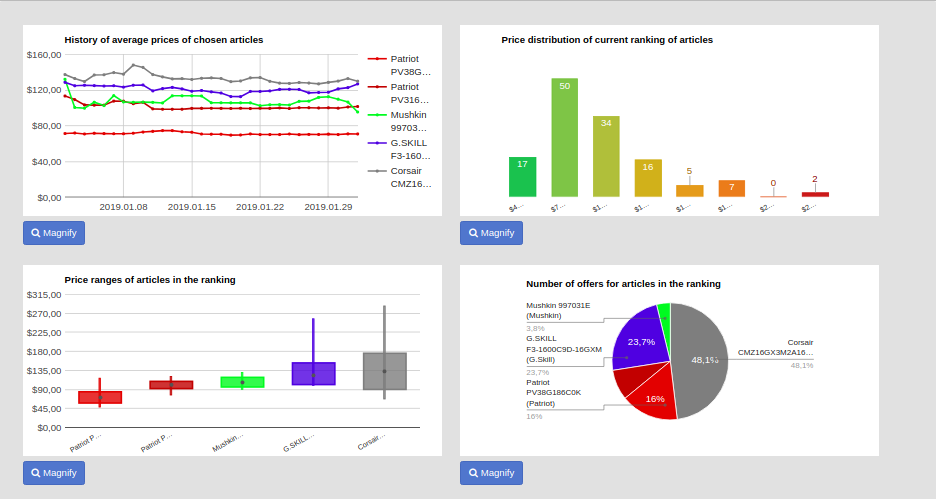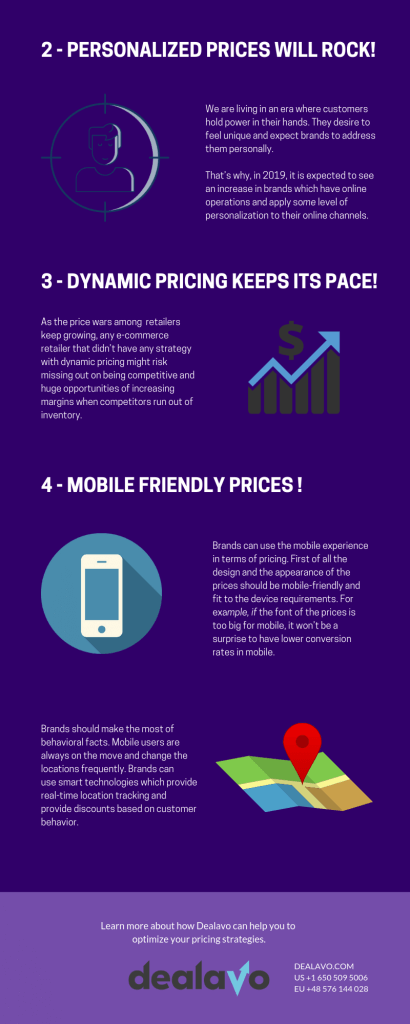
E-commerce Pricing in 2019 – what should we expect?
- 08 February 2019

The year 2018 proved us one more time the importance of online price management. One of the most recent researches, shows that 88% of online shoppers still want to see the most attractive price and 54% of them abandon their cart if they find a better deal.
That’s why monitoring e-commerce pricing trends should not be just a hobby or random activity both for brands and retailers.
Based on customer feedback and our experience, we have looked into our crystal ball for 2019 to provide you with four emerging online pricing trends alongside with sub-tips that will impact the online industry this year.
Let’s start then…
Optimizing Omnichannel Pricing in 2019

Today, customers have many touchpoints. In fact, these points are increasing day by day with the birth of new sales channels like new online retailers, mobile, in-store, social media which forms an immense omnichannel landscape. So, there is no just one specific purchase flow. For example, a random shopper can start searching for a product from the mobile app, come across the same on Google Shopping, see again in an online store and maybe finalize the purchasing process in a physical store.
So, conveying the brand message, crafting the product information and setting up the right price across channels is crucial to engage with shoppers in today’s retail environment.
Quick tip: Monitor your brand positioning and performance with Dealavo Brand E-Health in different channels. Closely monitor the positions at which your products are visible in the search results of specific phrases in different channels or track the ratings and comments of buyers to improve your products or services.
According to the 2018 Omnichannel Report; 62% of consumers have picked up an online order from a physical store in 2018 which is also called click & collect and shoppers who shop in more than one channel spend 2.7 times more money. Another research from HBR shows us that 86% of shoppers are regularly channel-hopping across at least two channels.
And, as the pricing is the most manipulative, quickest to change, have impact and no-required investment component in the complete structure of a retailer (cost, volumes, price), it should be handled very seriously.
The consequences of a random and uncontrollable omnichannel online pricing can cause ambiguity of prices, lesser profit margins and harming brand images for retailers.
That’s why, if you, as a retailer operating in both online and offline channels (e.g. Walmart, MediaMarkt) or as a brand who sells in various online stores (e.g. Sony selling in Target, E-bay), really want to be known for providing great customer experiences, omnichannel pricing is for you.
![]()
Before moving directly to our strategy for this year, explaining the online omnichannel pricing strategies and the possible use cases would be better.
There are 3 common omnichannel approaches that can work in omnichannel,
- Channel-specific pricing provides unique prices for each of the different channels which work best when the shopping journey is linear or particular customer segments prefer specific channel over another. For example an aged customer buying cosmetics in brick-and-mortar stores but a young shopper who prefers online stores.
- Omnichannel pricing enables to provide customers with constant prices among all different channels. This approach makes the customer experience and journey easier.
- Combination pricing is a combined approach, where the overall strategy is to offer one price across channels, but exceptions can be accepted. Perhaps the best example of this “exception” strategy is a single regular price, with channel or customer specific markdowns and promotions.
For retailers and brands, channel-specific pricing is not a preferable strategy if the consumers are able to detect the pricing desynchronization. Think about that if a buyer buys a product from your offline store at 100$ then founds the same at $80 in the online store. That experience can create a mistrust.
In addition to that, the term of channel conflict gains popularity as the number of channels increased and becomes a pain for brands.
What is channel conflict though?
The conflict of sales channels occurs when different partners compete for the customer with the same products, which can lead to significant discounts. Conflict can also occur when a new, competitive price distribution channel is introduced, which is perceived by other partners as a potential threat.
So, how to manage the omnichannel pricing, channel conflict and win in 2019?
If you are a retailer (e.g. MediaMarkt, Walmart), comprehensive and consistent pricing makes it clean for shoppers to engage both with your online and offline channels. Especially if customer retention is one of your primary goals in this year, omnichannel pricing can help to give you an edge on competitive pricing without disturbing the customers. Because they are sensitive to price differences, always questioning the reason of the difference and feel confused when they face various prices for the same product. So, this approach can build up customer loyalty by giving a great experience within the channels.
If you are a brand or a manufacturer (e.g. Sony, Toshiba, Nike), it is almost impossible to keep the prices same in all different online resellers’ stores because brands do not have very limited ability to intervene the retailers’ internal pricing decision. However, they can track their own products in different resellers’ online stores (e.g. Sony tracks Z97 model in Walmart, GearBest) and at least try to keep prices on a certain level in order to prevent fierce price competition made up by the online retailers. This approach is also called Minimum Advertised Price (MAP) Monitoring. Especially in US, brands have agreements with their re-sellers to ensure they don’t advertise their products below a certain price. With MAP approach, a brand can prevent the re-sellers to put their products in price competition. If the you are not able to control the price fluctuations of the products in re-sellers’ online stores, the prices may start decreasing uncontrollably within the channels.
However, European Union restricts brands to force some advertised price on resellers. That’s why manufacturers can only suggest a retail price for the EU resellers and must not enforce it. Manufacturer’s Suggested Retail Price (MSRP) which is applicable in Europe is the list price that the manufacturer believes their product should be sold for and matches the product value. With that approach, manufacturer takes in account all different variables like product cost, manufacturer margin, retailer margin and offer the resellers to use a final price.
As controlling the channels is almost impossible, using a minimum advertised price compliance software would be a wise move in 2019. These technologies provide you detailed information regarding the pricing activities of your distributors and swift recognition of price erosions (email notifications). If you detect the MAP violators, you can warn them first, then review the agreement or the relationship with them.
Even though the prices on each channel may be the same, you need to track and analyze what consumers want in each channel.
For example, how about the situation in giant retailers like Amazon? Do you think your prices are competitive enough in channels where the competition is rampant? Are you able to reach the data where you can detect the price reaction across channels? One of your product prices can work well in your own online store but may not reflect the same success in a different marketplace where the price competition is fierce. In this scenario, you should monitor your cross-channel numbers and how various prices affect sales.
Also, please keep in your mind that the market is dynamic and constantly evolving. So closely monitoring and looking back to historical data can provide you a better pricing forecasting abilities which helps you to optimize your strategy periodically.
2019 will be the year of running experiments on how to optimize the online prices within different channels. So, trying unique prices for different channels for some specific scenarios and adding a bit hybrid approach can also generate great results.
Brands operating own online channel can use it for user-specific scenarios. For example, a shopper may visit a product page multiple times but leaves the page without making any purchase. By making some little exceptions and embracing the hybrid approach, brands can display an ad on a different, personalized channels like Instagram or Facebook offering a special 20% discount for the product that the shopper had visited.
Personalized Prices Will Rock!
We are living in an era where customer holds the power in their hands. They desire to feel unique and expect from the brands to address them personally. That’s why, in 2019, it is expected to see an increase in brands which have online operations and apply some level of personalization to their online channels.
However, brands should make it wisely and in a proper way. The general assumption towards price personalization is much more about offering different prices to different segments than just based on their demographics.
But today’s price personalization exceeds beyond of that and reach a more sophisticated level of personalization based on user behavior. It goes a step further and covers on the interest of the shoppers, their interactions, their timing, the most engaged product page, etc…
Start with following the digital fingerprints of the online shopper;
- What are they buying?
- Where do they buy?
- How do they start the purchasing journey? – Maybe after coming home from a rock concert and pumped with emotions they look for music and merchandise online?
- Where do they stop proceeding towards the purchasing funnel?
Let’s look at a very quick example!
As a brand, you can melt product and price personalization in the same pot and offer a great experience to the shopper. Think about an online shopper visit Brogue Shoes and Slim Jeans page minimum 3 times but did not purchase anything.
In order to motivate the potential customer to finalize the purchase, the brands can offer a discount based on the historical behavior of a customer.
Dynamic Pricing Keeps Its Pace
Embraced by all types of online retailers and brands, dynamic pricing keeps its popularity and shows its impact on growing businesses. It seems to be one of the crucial strategies for businesses in 2019 again.
Before moving forward let’s make a quick difference between personalized pricing and dynamic pricing!
Dynamic Pricing is a strategy when prices are adjusted based on variables that are not directly related to the customer. Dynamic pricing focuses on the available supply and the competitor’s prices, stock status and provides the most optimal prices based on these variables. In other words, it helps retailers to set the best price at the right time in the right place by responding to the competitors’ move. On the other hand, as mentioned above, the goal of personalized pricing is that the retailer has an idea of who the customer is and incentivizes the customer based on their previous behavior and actions.
So, as the price wars among the retailers (Amazon changes its prices, on average, every ten minutes to stay competitive), marketplaces, and channels keep growing, any e-commerce retailer that didn’t have some form of dynamic pricing embraced might risk missing out the competition and huge opportunities of increasing margins when competitors run out of inventory.

With the help of Dealavo Dynamic Pricing tool you will be able to monitor your competition and automatically adjust your prices to the situation on the market. Exemplary data shown in the picture above.
Mobile Friendly Prices
The popularity of mobile seems to never end. People are becoming more and more engaged with their smartphones. That’s why, brands need to make sure that the mobile shopping experience should be designed very well and reach a world-class level.

Also, there are many utilities that brands can use with the mobile experience in terms of pricing. First of all the design and the appearance of prices should be mobile-friendly and fit to the device experience. For example, if the font of prices is too big for mobile, it won’t be a surprise to have lower conversion rates in mobile.
Brands should also make the advantage of behavioral facts of mobile. As you should definitely know, mobile users are always in a move and change the locations frequently. Brands can use smart technologies which provide real-time location tracking and provide discounts based on their behaviors.
For example, if the brand is able to detect if the audience visits a competitor offline store, the marketing manager can launch a personalized and special price in order to acquire client.
Actually, sky is the limit here. There are tons of ideas that you can create and run your creativity.

Conclusion
We’ve presented you with 5 different pricing approaches for the new year to help you get on your way and make 2019 the best year yet for your online performance.
Let’s summarize our predictions and suggestions for 2019:
- Focus on Omnichannel, be consistent on different channels but do some exceptions if you see an opportunity.
- Try to avoid channel conflict. All of our partners are valuable!
- Customize the prices based on the customers’ previous behavior and actions.
- Dynamic pricing still keeps its popularity. Beat the competition in a smart way!
- Mobile is the king! Don’t forget it and optimize your price based on mobile requirements.
Do you have any other ideas? What are your expectations from 2019? Please do not hesitate to drop your comments. We would be more than happy to enrich our content with your valuable feedback.